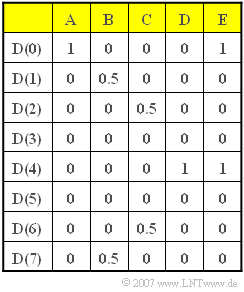Difference between revisions of "Aufgaben:Exercise 5.2: Inverse Discrete Fourier Transform"
| Line 39: | Line 39: | ||
*This task belongs to the chapter [[Signal_Representation/Discrete_Fourier_Transform_(DFT)|Discrete Fourier Transformation (DFT)]]. | *This task belongs to the chapter [[Signal_Representation/Discrete_Fourier_Transform_(DFT)|Discrete Fourier Transformation (DFT)]]. | ||
| − | *The topic dealt with here is also dealt with in the interactive applet [[Applets: | + | *The topic dealt with here is also dealt with in the interactive applet [[Applets:Discrete_Fouriertransform_and_Inverse|Discrete Fourier Transform and Inverse]]. |
Revision as of 15:17, 16 May 2021
With the Discrete Fourier Transform $\rm (DFT)$,
- the $N$ spectral range coefficients $D(\mu)$ are calculated
- from the $N$ time coefficients $d(\nu)$ ⇒ samples of the continuous-time signal $x(t)$.
With $\nu = 0$, ... , $N – 1$ and $\mu = 0$, ... , $N – 1$ holds:
- $$D(\mu) = \frac{1}{N} \cdot \sum_{\nu = 0 }^{N-1} d(\nu)\cdot {w}^{\hspace{0.05cm}\nu \hspace{0.05cm} \cdot \hspace{0.05cm}\mu} \hspace{0.05cm}.$$
Here $w$ denotes the complex rotation factor:
- $$w = {\rm e}^{-{\rm j} \hspace{0.05cm}\cdot \hspace{0.05cm} 2 \pi /N} = \cos \left( {2 \pi}/{N}\right)-{\rm j} \cdot \sin \left( {2 \pi}/{N}\right) \hspace{0.05cm}.$$
For the Inverse Discrete Fourier Transform $\rm (DFT)$ ⇒ "inverse function" of the DFT, the following applies accordingly:
- $$d(\nu) = \sum_{\mu = 0 }^{N-1} D(\mu) \cdot {w}^{-\nu \hspace{0.05cm} \cdot \hspace{0.05cm}\mu} \hspace{0.05cm}.$$
In this task, the time coefficients $d(\nu)$ are to be determined for various sequences $D(\mu)$ (which are labelled $\rm A$, ... , $\rm E$ in the table above). Thus, $N = 8$ always applies.
Hints:
- This task belongs to the chapter Discrete Fourier Transformation (DFT).
- The topic dealt with here is also dealt with in the interactive applet Discrete Fourier Transform and Inverse.
Questions
Solution
- $$d(\nu) = D(0) \cdot w^0 = D(0) =1\hspace{0.5cm}(0 \le \nu \le 7)\ \hspace{0.5cm} \Rightarrow\hspace{0.5cm}\hspace{0.15 cm}\underline{d(0) = d(1) = 1}.$$
- This set of parameters describes the discrete form of the Fourier correspondence of the DC signal:
- $$x(t) = 1 \hspace{0.2cm}\circ\!\!-\!\!\!-\!\!\!-\!\!\bullet\, \hspace{0.2cm} X(f) = {\delta}(f) \hspace{0.05cm}.$$
(2) All spectral coefficients are zero except $D_1 = D_7 = 0.5$. It follows for $0 ≤ ν ≤ 7$:
- $$d(\nu) = 0.5 \cdot {\rm e}^{-{\rm j} \hspace{0.05cm}\cdot \hspace{0.05cm} (\pi /4) \hspace{0.05cm}\cdot \hspace{0.05cm} \nu} + 0.5 \cdot {\rm e}^{-{\rm j} \hspace{0.05cm}\cdot \hspace{0.05cm} (\pi /4) \hspace{0.05cm}\cdot \hspace{0.05cm} \nu} \hspace{0.05cm}.$$
- However, due to periodicity, also holds:
- $$d(\nu) = 0.5 \cdot {\rm e}^{-{\rm j} \hspace{0.05cm}\cdot \hspace{0.05cm} (\pi /4) \hspace{0.05cm}\cdot \hspace{0.05cm} \nu} + 0.5 \cdot {\rm e}^{{\rm j} \hspace{0.05cm}\cdot \hspace{0.05cm} (\pi /4) \hspace{0.05cm}\cdot \hspace{0.05cm} \nu} = \cos \left({\pi}/{4} \cdot \nu \right) \hspace{0.3cm} \Rightarrow \hspace{0.3cm}\hspace{0.15 cm}\underline{d(0) = 1}, \hspace{0.2cm}\hspace{0.15 cm}\underline{d(1) = {1}/{\sqrt{2}} \approx 0.707} \hspace{0.05cm}.$$
- It is therefore the discrete-time equivalent of
- $$x(t) = \cos(2 \pi \cdot f_{\rm A} \cdot t) \hspace{0.2cm}\circ\!\!-\!\!\!-\!\!\!-\!\!\bullet\, \hspace{0.2cm} X(f) = {1}/{2} \cdot {\delta}(f + f_{\rm A}) + {1}/{2} \cdot {\delta}(f - f_{\rm A}) \hspace{0.05cm},$$
- where $f_{\rm A}$ denotes the smallest frequency that can be represented in the DFT.
(3) Compared to subtask (2) , the oscillation frequency is now twice as large, namely $2 f_{\rm A}$ instead of $f_{\rm A}$:
- $$x(t) = \cos(2 \pi \cdot (2f_{\rm A}) \cdot t) \hspace{0.2cm}\circ\!\!-\!\!\!-\!\!\!-\!\!\bullet\, \hspace{0.2cm} X(f) = {1}/{2} \cdot {\delta}(f + 2f_{\rm A}) + {1}/{2} \cdot {\delta}(f - 2f_{\rm A}) \hspace{0.05cm},$$
- Thus the sequence $\langle \hspace{0.1cm}d(ν)\hspace{0.1cm}\rangle $ describes two periods of the cosine oscillation, and it holds for $0 ≤ ν ≤ 7$:
- $$ d(\nu) = 0.5 \cdot {\rm e}^{-{\rm j} \hspace{0.05cm}\cdot \hspace{0.05cm} (\pi /2) \hspace{0.05cm}\cdot \hspace{0.05cm} \nu} + 0.5 \cdot {\rm e}^{{\rm j} \hspace{0.05cm}\cdot \hspace{0.05cm} (\pi /2) \hspace{0.05cm}\cdot \hspace{0.05cm} \nu} = \cos \left({\pi}/{2} \cdot \nu \right)\hspace{0.3cm} \Rightarrow \hspace{0.3cm}\hspace{0.15 cm}\underline{d(0) = 1, \hspace{0.2cm}d(1) = 0} \hspace{0.05cm}.$$
(4) By further doubling the cosine frequency to $4 f_{\rm A}$ one finally arrives at the continuous-time Fourier correspondence
- $$d(\nu) = 0.5 \cdot {\rm e}^{-{\rm j} \hspace{0.05cm}\cdot \hspace{0.05cm} \pi \hspace{0.05cm}\cdot \hspace{0.05cm} \nu} + 0.5 \cdot {\rm e}^{{\rm j} \hspace{0.05cm}\cdot \hspace{0.05cm} \pi \hspace{0.05cm}\cdot \hspace{0.05cm} \nu} = \cos \left(\pi \cdot \nu \right) \hspace{0.05cm}$$
- and thus to the time coefficients
- $$d(0) =d(2) =d(4) =d(6) \hspace{0.15 cm}\underline{= +1}, \hspace{0.2cm}d(1) =d(3) =d(5) =d(7) \hspace{0.15 cm}\underline{= -1} \hspace{0.05cm}.$$
- Note that here the two Dirac functions coincide in the discrete-time representation due to periodicity.
- The coefficients $D (+4) = 0.5$ and $D (-4) = 0.5$ together give $D (4) = 1$.
(5) The Discrete Fourier Transform is also linear. Therefore, the superposition principle is still applicable:
- The coefficients $D(\mu )$ from column $\rm E$ result as the sums of columns $\rm A$ and $\rm D$.
- Therefore, the alternating sequence $\langle \hspace{0.1cm}d(ν) \hspace{0.1cm}\rangle $ becomes the sequence shifted up by $1$ according to subtask (4) :
- $$ \hspace{0.15 cm}\underline{d(0) =d(2) =d(4) =d(6)= 2}, \hspace{0.2cm}\hspace{0.15 cm}\underline{d(1) =d(3) =d(5) =d(7) = 0} \hspace{0.05cm}.$$
